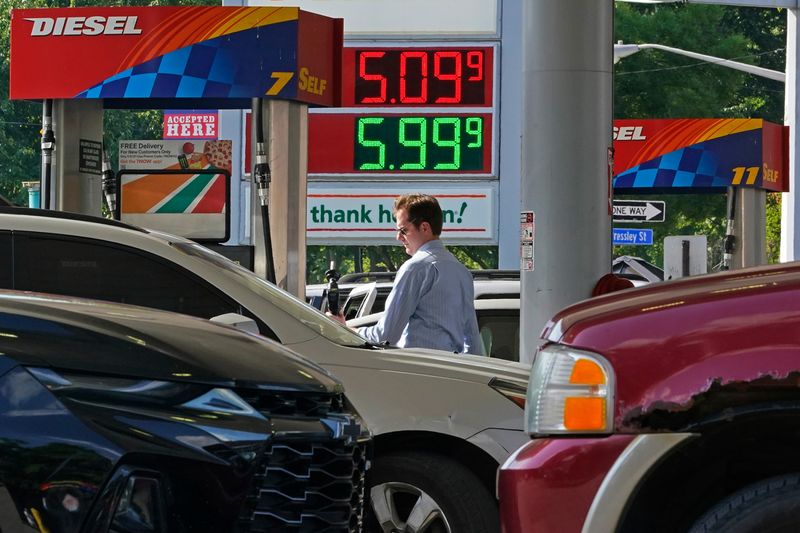“The world has never witnessed such a major energy crisis in terms of its depth and its complexity,” Fatih Birol, executive director of the International Energy Agency (IEA), said at a forum on July 12. “We might not have seen the worst of it yet—this is affecting the entire world.”
Global Oil Demand
The impact on global economics and politics is profound. A 42% runup in gasoline prices this year has already driven inflation in the US to the highest in a generation and helped put the Republican Party on course to retake Congress in this year’s midterm elections. High fuel costs are sparking unrest in countries from Peru to Sri Lanka. The energy transition world leaders have been talking about for years is at risk of being sidelined.
Supply will have a tough time keeping up. In June, JPMorgan Chase & Co. painted one apocalyptic scenario in which Putin holds back millions of barrels of Russian oil from the market and prices rocket to $380 a barrel. Although the nation has found willing buyers in China and India, Russia’s overall production has fallen by more than a million barrels a day, weighed down by sanctions and a broad reluctance to do business with Moscow.
The prospects for finding production growth outside of Russia are dim. OPEC, which produces about 40% of the world’s crude, is finding it difficult to meet production targets. Aging infrastructure, years of historically low investment, and political trauma have combined to hold back output. In May, OPEC+ (the Organization of the Petroleum Exporting Countries and allies) produced 2.7 million barrels a day less than its collective target.
Hopes for more oil supply rest on the two members with surplus production capacity: Saudi Arabia and the United Arab Emirates. President Joe Biden has pushed both to pump more. In a testament to how desperate he’s become to reduce oil prices, Biden planned to visit Saudi Arabia this month and meet Crown Prince Mohammed bin Salman—a man he had previously refused to speak with, even by phone, partly because of his role in the murder of columnist Jamal Khashoggi.
As for the UAE, French President Emmanuel Macron was caught on camera at a Group of Seven meeting saying the nation’s president had told him it was already at maximum production.
There are no signs that America’s shale industry is ready—or willing—to bail out the world. True, production is rising in the giant Permian Basin of Texas and New Mexico. But the rest of the US oil industry is stagnating. Overall US output is still about 1 million barrels a day short of its pre-pandemic peak.
It’s not just that oil producers can’t produce more oil. Some don’t want to. The world’s five largest oil companies plan to invest $81.7 billion this year, half of what they spent in 2013. US shale drillers have been trying to rein in spending after years of burning through cash with little to show for it. European oil majors are diverting capital away from oil and toward lower-carbon energy.
Against all the supply-side woes is the surge in demand. After two years of Covid restrictions, people are taking to the roads and air by the hundreds of millions. Halfway through summer, demand is already close to matching pre-pandemic levels. And China hasn’t even fully emerged from lockdowns yet.
Sure, central bankers are raising interest rates, and the prospect of a global recession has investors concerned that demand is about to fall off a cliff. But economic downturns have rarely caused fuel demand to tank. Outside the pandemic-induced contraction, the only modern example of a major decline is the global financial crisis. More typically, consumption simply rises more slowly.
Some will say a high oil price is what the world needs to wean itself off fossil fuels. But the reality is it makes a transition even more challenging.
In times such as these, even the most climate-conscious governments tend to buckle, granting tax breaks and spending billions of dollars to keep conventional fuels affordable. More than 20 countries have created subsidies to provide relief at the pump, according to data compiled by Bloomberg News. And because expensive oil is driving up inflation and prompting interest rate increases, renewable energy companies face a higher cost of capital.
The world’s 20 million electric cars aren’t enough to cut oil demand. BloombergNEF, which issues a long-term EV forecast annually, expects crude demand from road transport to peak in 2027.
Not everyone is a bull. Citigroup Inc. published a recent note that predicted oil could tumble to $65 a barrel in the event of a recession. Oil demand may drop only in “the worst global recessions,” the bank said. “But oil prices fall in all recessions.”
On July 8, Putin warned of the opposite. Western nations made a mistake when they sanctioned his nation’s energy supplies, he said. Should they continue, he said, the global energy market faces “even more severe, without exaggeration, even catastrophic consequences.”

